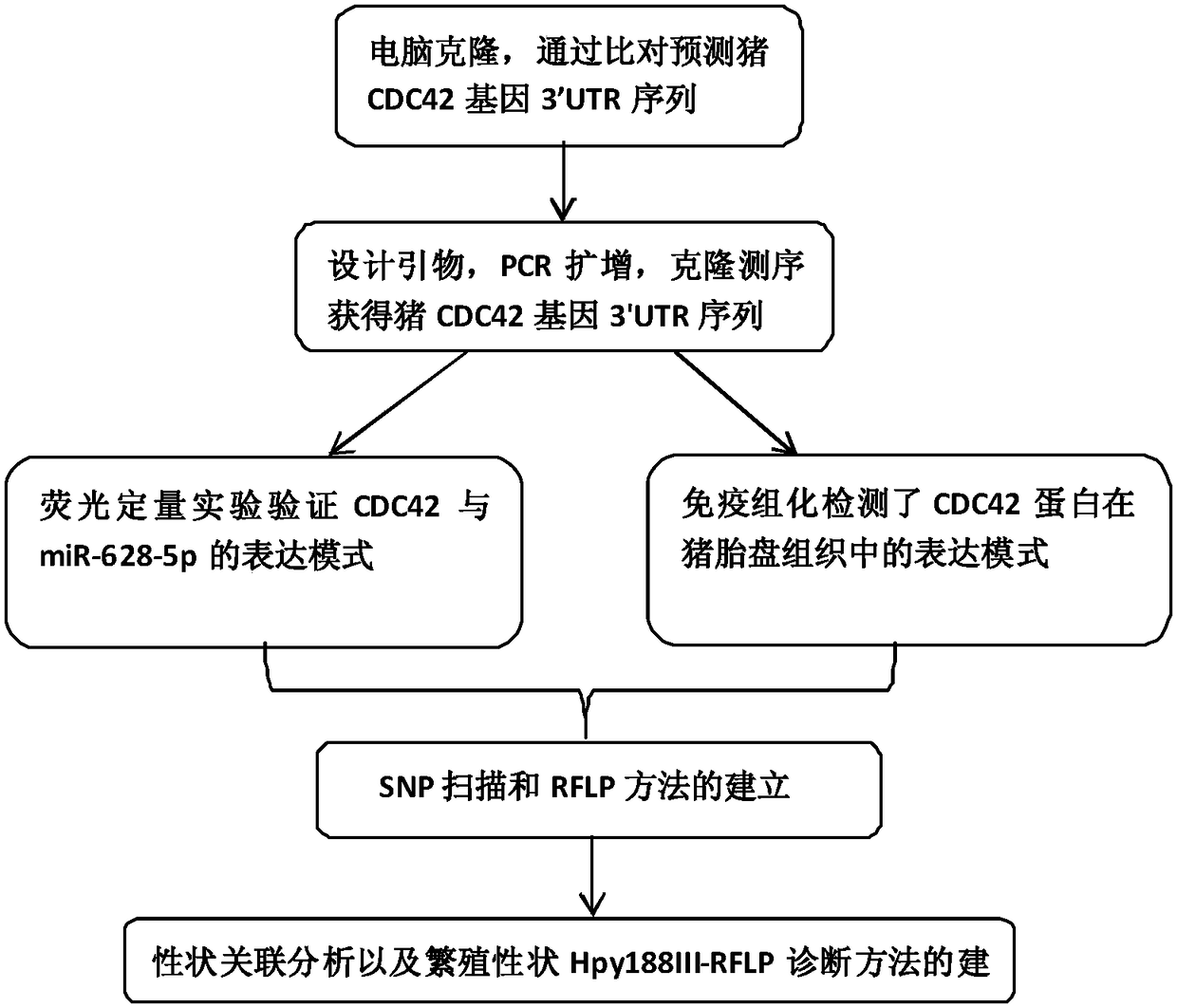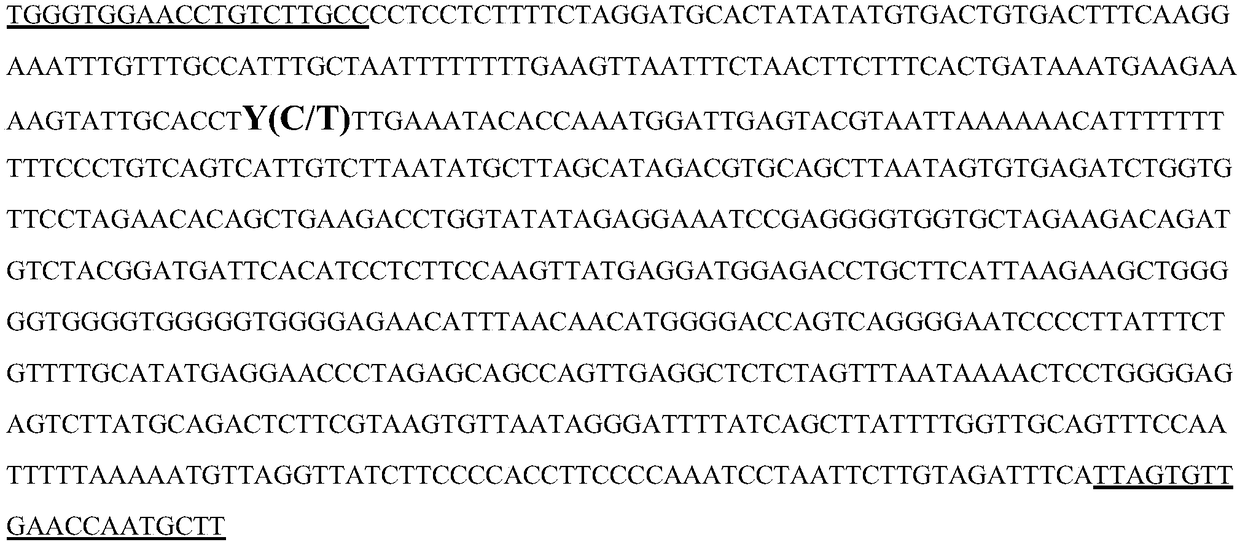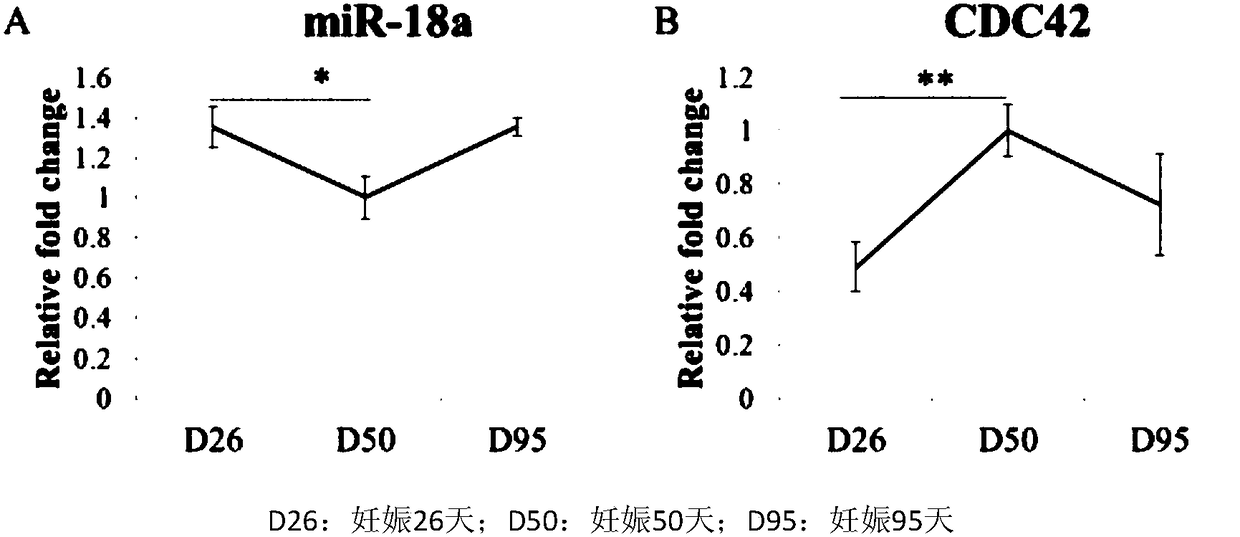Cloning and application of CDC42 gene molecular marker related to porcine reproductive traits
A molecular marker, pig reproduction technology, applied in recombinant DNA technology, microbial determination/inspection, DNA/RNA fragments, etc.
- Summary
- Abstract
- Description
- Claims
- Application Information
AI Technical Summary
Problems solved by technology
Method used
Image
Examples
Embodiment 1
[0031] Example 1 Cloning of CDC42 gene
[0032] (1) Primer design
[0033] Use the 3'UTR sequence of the porcine CDC42 gene provided in NCBI as the reference sequence to design the following primers for PCR amplification, and the nucleotide sequence of the primer pair is as follows:
[0034] Primer combination sequence for amplifying the CDC42 gene fragment:
[0035] Forward primer: 5′-TGCCAAGAATAAACAGAAGCCTA-3′
[0036] Reverse primer: 5′-TTGTGAAGGGTTTTTTGTTTGTTTAATAC-3′
[0037] (2) Cloning and sequencing of PCR products
[0038] The purified PCR product was connected to the pMD-18T vector (purchased from Treasure Bioengineering Dalian Co., Ltd.) overnight at 4°C in a water bath; under sterile conditions, 100-120 μl of competent cells were placed in a 1.5ml Ependorff tube, and 5 μl of The ligation product was added and mixed, placed on ice for 30 minutes, heat-shocked at 42°C for 90s, ice-bathed for 3-4 minutes, added 400 μl LB liquid medium without antibiotics, and incu...
Embodiment 2
[0039] Example 2 Immunohistochemical test of CDC42 gene fragment in placental tissue
[0040] (1) Collection of pig placental tissue samples
[0041] Pregnant sows (Large White pig breed, from the boutique pig farm of Huazhong Agricultural University) were selected and slaughtered to collect pig placental tissue samples on the 26th, 50th, and 95th days after pregnancy.
[0042] (2) Preparation of paraffin tissue sections
[0043] Take the tissue and fix it in 10% neutral formalin fixative for about 48 hours, then trim the tissue block, put the tissue into the tissue frame quickly, rinse it with tap water overnight, and then soak it in distilled water for 10 minutes. Soak the tissue in low-concentration alcohol to high-concentration alcohol in sequence, namely 70%, 80%, 90%, 95% (I, II), absolute ethanol (I, II) for 2 hours each. Put the tissue into xylene (Ⅰ, Ⅱ) until transparent, the time is about 15min each. The transparent tissues were placed in paraffin wax (Ⅰ, Ⅱ) at 60...
Embodiment 3
[0048] Embodiment 3 Establishment of PCR-RFLP diagnostic method
[0049] (1) Design the primer combination shown below
[0050] Forward primer: 5'-TGGGTGGAACCTGTCTTGCC-3',
[0051] Reverse primer: 5'-AAGCATTGGTTCAACACTAA-3'.
[0052] (2) PCR amplification conditions
[0053] The total volume of the PCR reaction is 10 μl, including about 100 ng of porcine genomic DNA, 5 μl of PCR Mix, 0.2 μl each of forward primer and reverse primer (from this example). PCR amplification program: 94°C for 5min, 32 cycles of 94°C for 30s, 60°C for 30s, then 72°C for 15s, and finally 72°C for 5min. The PCR reaction product was detected by 2% agarose gel electrophoresis, and a 682bp specific amplification fragment (ie, SEQ ID NO: 1) was obtained. Sequencing results revealed that the 151bp fragment had a Hpy188III restriction site, which was the polymorphic site.
[0054] (3) PCR-RFLP detection conditions
[0055] The volume of PCR product digestion reaction is 10 μl, including 1 μl of 1× buf...
PUM
 Login to View More
Login to View More Abstract
Description
Claims
Application Information
 Login to View More
Login to View More - R&D Engineer
- R&D Manager
- IP Professional
- Industry Leading Data Capabilities
- Powerful AI technology
- Patent DNA Extraction
Browse by: Latest US Patents, China's latest patents, Technical Efficacy Thesaurus, Application Domain, Technology Topic, Popular Technical Reports.
© 2024 PatSnap. All rights reserved.Legal|Privacy policy|Modern Slavery Act Transparency Statement|Sitemap|About US| Contact US: help@patsnap.com










